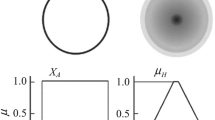Abstract
The paper presents an intelligent information system for solving the urgent problem for determining the significance of risk in the activities of testing laboratories. The algorithm of the system functioning is based on fuzzy logic inference of the assessment of risk significance. The expediency of this approach is stipulated by the expert nature of information about the parameters of risks, the availability of subjective judgements and fuzzy knowledge. As a result of study of the object domain, the input attributes have been established – the possibility of risk and the severity of risk consequences which determine the output parameter – the significance of the risk. Based on the expert knowledge, the corresponding linguistic variables have been introduced, basic and extended term-sets have been established, membership functions have been constructed. As a result of processing and analyzing the consistency of the expert information, the optimal models of linguistic variables have been chosen. The system of production rules being in the basis of fuzzy inference of the solution – assessment of risk significance – have been created. Recommendations for risk management have been developed for each level of the risk. On the basis of this algorithm, an original program has been created which makes it possible to instantly get information about the significance of the arising risks and take necessary measures under the conditions of continuous operation of the laboratory. The illustrations of the program running have been presented.
Access this chapter
Tax calculation will be finalised at checkout
Purchases are for personal use only
Similar content being viewed by others
References
Kaplan, R.S., Leonard, D., Mikes, A.: Novel Risks. Working Paper of Harvard Business School 20-094, pp. 1–26 (2020)
RF Ministry of Economic Development Order of 30.05.2014 N 326. On approval of the accreditation criteria, the list of documents confirming compliance of the applicant, the accredited person with the accreditation criteria, and the list of documents in the field of standardization, compliance with the requirements of which by applicants, accredited persons ensures their compliance with the accreditation criteria (as amended RF Ministry of Economic Development Order of 19.08.2019 N 506). https://fsa.gov.ru/documents/9557/. Accessed 10 Apr 2021
International Organization for Standardization. ISO 31000. Risk Management - Guidelines, ISO, 2nd ed., Geneva, Switzerland (2018). https://iso-management.com/wp-content/uploads/2019/03/ISO-31000-2018.pdf. Accessed 10 Apr 2021
State Standard ISO/IEC 17025. General requirements for the competence of testing and calibration laboratories. http://docs.cntd.ru/document/1200166732. Accessed 10 Apr 2021
Filyppova, S., Bashynska, I., Kholod, B., Prodanova, L., Ivanchenkova, L., Ivanchenkov, V.: Risk management through systematization: risk management culture. Int. J. Recent Technol. Eng. 8(3), 6047–6052 (2019)
Vasilňáková, A.: Risk management in accredited testing laboratories. In: Proceedings of the 29th International DAAAM Symposium, pp. 1071–1075 (2018)
State Standard P 51901.12˗2007 “Risk management. Procedure for failure mode and effects analysis.” http://docs.cntd.ru/document/gost-r-51901-12-2007. Accessed 10 Apr 2021
Wong, S.-K.: Risk-based thinking for chemical testing. Accred. Qual. Assur. 22(2), 103–108 (2017)
Eliza, R.D., Minodora, D.: Risk management in clinical laboratory. Acta Med. Marisien. 61(4), 372–377 (2015)
Runje, B., Horvatic Novak, A., Razumic, A., Piljek, P., Strbac, B., Orosnjak, M.: Evaluation of consumer and producer risk in conformity assessment decisions. In: Proceedings of the 30th DAAAM International Symposium, pp. 0054–0058 (2019)
Kharlamov, M.M., Kolmykova, T.S., Tolstykh, T.O., Nesenyuk, E.S., Garina, E.P.: Analytical procedures for assessing the risks of introducing innovative technologies into the organization’s activities. In: Popkova, E.G., Sergi, B.S. (eds.) The 21st Century from the Positions of Modern Science: Intellectual, Digital and Innovative Aspects, pp. 654–662. Springer International Publishing, Cham (2020). https://doi.org/10.1007/978-3-030-32015-7_73
Yazdi, M., Kabir, S.: Fuzzy evidence theory and bayesian networks for process systems risk analysis. Hum. Ecol. Risk Assess. Int. J. 26(1), 57–86 (2018)
Asai, K., Vatada, D., Sugeno, S.: Applied Fuzzy Systems. Mir, Moscow (1993)
Averkin, A.N., Batyrshin, I.Z., Blishun, A.F., Silov, V.B., Tarasov, V.B.: Fuzzy sets in the models of management and artificial intelligence. Nauka, Moscow (1986)
Nurutdinova, I., Dimitrova, L.: Intelligent system for assessing organization’s possibilities to achieve sustained success. In: Abraham, A., Kovalev, S., Tarassov, V., Snasel, V., Sukhanov, A. (eds.) 2018. AISC, vol. 875, pp. 379–388. Springer, Cham (2019). https://doi.org/10.1007/978-3-030-01821-4_40
Borisova, L.V., Dimitrov, V.P.: A linguistic approach to solving of the problem of technological adjustment of combines. Mordovia Univ. Bul. 27(2), 178–189 (2017)
Borisova, L., Dimitrov, V., Nurutdinova, I.: Algorithm for assessing quality of fuzzy expert information. In: Proceedings of IEEE East˗West Design and Test Symposium (EWDTS 2017), Novi Sad, Serbia, pp. 319˗322 (2017)
Kofman, A.: Introduction in the Theory of Fuzzy Sets. Radio i svyaz’, Moscow (1982)
Saaty, T.L., Kearns, K.P.: Analytical Planning. The Organization of Systems. Radio i svyaz’, Moscow (1993)
Dimitrova, L.A.: Some aspects of formalizing risk management knowledge: In: Science of the Young - The Future Of Russia. Collection of Scientific Articles of the 5th International Scientific Conference of Promising Developments of Young Scientists in 4 v’s, vol. 1, pp. 37˗40. Southwestern State University, Kursk (2020)
Dimitrov, V.P., Borisova, L.V., Nurutdinova, I.N., Bogatyreva, E.V.: Software system for inputting expert knowledge. Don State Tech. Univ. Bull. 11, 83–90 (2011)
Author information
Authors and Affiliations
Editor information
Editors and Affiliations
Rights and permissions
Copyright information
© 2022 The Author(s), under exclusive license to Springer Nature Switzerland AG
About this paper
Cite this paper
Nurutdinova, I., Dimitrova, L. (2022). Intelligent Decision Support System When Assessing Risk Significance. In: Kovalev, S., Tarassov, V., Snasel, V., Sukhanov, A. (eds) Proceedings of the Fifth International Scientific Conference “Intelligent Information Technologies for Industry” (IITI’21). IITI 2021. Lecture Notes in Networks and Systems, vol 330. Springer, Cham. https://doi.org/10.1007/978-3-030-87178-9_38
Download citation
DOI: https://doi.org/10.1007/978-3-030-87178-9_38
Published:
Publisher Name: Springer, Cham
Print ISBN: 978-3-030-87177-2
Online ISBN: 978-3-030-87178-9
eBook Packages: Intelligent Technologies and RoboticsIntelligent Technologies and Robotics (R0)




